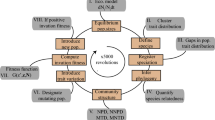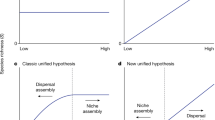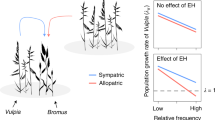Abstract
Diversity in biological communities is a historical product of immigration, diversification and extinction1,2,3,4, but the combined effect of these processes is poorly understood. Here we show that the order and timing of immigration controls the extent of diversification. When an ancestral bacterial genotype was introduced into a spatially structured habitat, it rapidly diversified into multiple niche-specialist types5. However, diversification was suppressed when a niche-specialist type was introduced before, or shortly after, introduction of the ancestral genotype. In contrast, little suppression occurred when the same niche specialist was introduced relatively late. The negative impact of early arriving immigrants was attributable to the historically sensitive outcome of interactions involving neutral competition3 and indirect facilitation. Ultimately, the entire boom-and-bust dynamics of adaptive radiation were altered. These results demonstrate that immigration and diversification are tightly linked processes, with small differences in immigration history greatly affecting the evolutionary emergence of diversity.
This is a preview of subscription content, access via your institution
Access options
Subscribe to this journal
Receive 51 print issues and online access
$199.00 per year
only $3.90 per issue
Buy this article
- Purchase on Springer Link
- Instant access to full article PDF
Prices may be subject to local taxes which are calculated during checkout




Similar content being viewed by others
References
Ricklefs, R. E. & Schluter, D. .Species Diversity in Ecological Communities: Historical and Geographical Perspectives (Univ. Chicago Press, Chicago, 1993)
Losos, J. B. & Schluter, D. Analysis of an evolutionary species-area relationship. Nature 408, 847–850 (2000)
Hubbell, S. P. The Unified Neutral Theory of Biodiversity and Biogeography (Princeton Univ. Press, Princeton, 2001)
Gillespie, R. G. Community assembly through adaptive radiation in Hawaiian spiders. Science 303, 356–359 (2004)
Rainey, P. B. & Travisano, M. Adaptive radiation in a heterogeneous environment. Nature 394, 69–72 (1998)
MacArthur, R. H. & Wilson, E. O. The Theory of Island Biogeography (Princeton Univ. Press, Princeton, 1967)
Connor, E. F. & McCoy, E. D. The statistics and biology of the species-area relationship. Am. Nat. 113, 791–833 (1979)
Drake, J. A. Community-assembly mechanics and the structure of an experimental species ensemble. Am. Nat. 137, 1–26 (1991)
Weiher, E. & Keddy, P. A. Ecological Assembly Rules: Perspectives, Advances, Retreats (Cambridge Univ. Press, Cambridge, 1999)
Chase, J. M. Community assembly: when should history matter?. Oecologia 136, 489–498 (2003)
Fukami, T. & Morin, P. J. Productivity-biodiversity relationships depend on the history of community assembly. Nature 424, 423–426 (2003)
Emerson, B. C. & Kolm, N. Species diversity can drive speciation. Nature 434, 1015–1017 (2005)
Travisano, M., Mongold, J. A., Bennett, A. F. & Lenski, R. E. Experimental tests of the roles of adaptation, chance, and history in evolution. Science 267, 87–90 (1995)
Losos, J. B., Jackman, T. R., Larson, A., de Queiroz, K. & Rodriguez-Schettino, L. Contingency and determinism in replicated adaptive radiations of island lizards. Science 279, 2115–2118 (1998)
Taylor, E. B. & McPhail, J. D. Historical contingency and ecological determinism interact to prime speciation in sticklebacks, Gasterosteus.. Proc. R. Soc. B 267, 2375–2384 (2000)
Schluter, D. The Ecology of Adaptive Radiation (Oxford Univ. Press, Oxford, 2000)
Gillespie, R. G., Palumbi, S. R. & Croom, H. B. Multiple origins of a spider radiation in Hawaii. Proc. Natl Acad. Sci. USA 91, 2290–2294 (1994)
Emerson, B. C. Evolution on oceanic islands: molecular phylogenetic approaches to understanding pattern and process. Mol. Ecol. 11, 951–966 (2002)
Webb, C. O., Ackerly, D. D., McPeeck, M. A. & Donoghue, M. J. Phylogenies and community ecology. Annu. Rev. Ecol. Syst. 33, 475–505 (2002)
Emerson, B. C. & Oromí, P. Diversification of the forest beetle genus Tarphius in the Canary Islands, and the evolutionary origins of island endemics. Evolution 59, 586–598 (2005)
Losos, J. B. & Glor, R. E. Phylogenetic comparative methods and the geography of speciation. Trends Ecol. Evol. 18, 220–227 (2003)
Kassen, R., Llewellyn, M. & Rainey, P. B. Ecological constraints on diversification in a model adaptive radiation. Nature 451, 984–988 (2004)
Rainey, P. B. in The Influence of Cooperative Bacteria on Animal Host Biology (eds McFall-Ngai, M. J., Henderson, B. & Ruby, E. G.) 83–100 (Cambridge Univ. Press, Cambridge, 2005)
Goymer, P. et al. Adaptive divergence in experimental populations of Pseudomonas fluorescens. II. Role of the GGDEF regulator WspR in evolution and development of the wrinkly spreader phenotype. Genetics 173, 515–526 (2006)
Doebeli, M. & Dieckmann, U. Speciation along environmental gradients. Nature 421, 259–264 (2003)
Gavrilets, S. & Vose, A. Dynamic patterns of adaptive radiation. Proc. Natl Acad. Sci. USA 102, 18040–18045 (2005)
Seehausen, O. African cichlid fish: a model system in adaptive radiation research. Proc. R. Soc. Lond. B 273, 1987–1998 (2006)
Cowie, R. H. Variation in species diversity and shell shape in Hawaiian land snails: in situ speciation and ecological relationships. Evolution 49, 1191–1202 (1995)
Fukami, T., Bezemer, T. M., Mortimer, S. R. & Van der Putten, W. H. Species divergence and trait convergence in experimental plant community assembly. Ecol. Lett. 8, 1283–1290 (2005)
Rainey, P. B. Adaptation of Pseudomonas fluorescens to the plant rhizosphere. Environ. Microbiol. 1, 243–257 (1999)
Acknowledgements
We thank P. Meintjes for assistance, and B. Emerson, R. Kassen and the members of the Rainey laboratory for comments. This work was supported by the Marsden Fund Council from government funding administered by the Royal Society of New Zealand, and by the Japan Society for the Promotion of Science.
Author Contributions T.F. developed the concepts, designed the main experiment with P.B.R., collected and analysed the primary data, and wrote the manuscript in conjunction with P.B.R. and H.J.E.B. H.J.E.B. and P.B.R. conceptualized the SMmsc genotype, which was constructed and validated by H.J.E.B. X.-X.Z. designed, constructed and validated lacZ-marked SBW25. H.J.E.B. and T.F. performed selection experiments.
Author information
Authors and Affiliations
Corresponding author
Ethics declarations
Competing interests
Reprints and permissions information is available at www.nature.com/reprints. The authors declare no competing financial interests.
Supplementary information
Supplementary Information
This file contains Supplementary Discussion 1 and 2 and Supplementary Figures 1-2. Supplementary Discussion 1 explains why the boom-and-bust dynamics have parallels with similar dynamics observed in macro-organisms. Supplementary Discussion 2 provides further detail on the results of the experiments that used SMmsc. Supplementary Figure 1 shows the relationship between relative immigration timing and population size and initial population growth rate. Supplementary Figure 2 shows detection of SMmsc-derived WS genotypes in microcosms in which diversification was suppressed by early introduction of small-WS. (PDF 315 kb)
Rights and permissions
About this article
Cite this article
Fukami, T., Beaumont, H., Zhang, XX. et al. Immigration history controls diversification in experimental adaptive radiation. Nature 446, 436–439 (2007). https://doi.org/10.1038/nature05629
Received:
Accepted:
Issue Date:
DOI: https://doi.org/10.1038/nature05629
This article is cited by
-
A continuous fish fossil record reveals key insights into adaptive radiation
Nature (2023)
-
Speciation in a MacArthur model predicts growth, stability, and adaptation in ecosystem dynamics
Theoretical Ecology (2023)
-
Priority effects in microbiome assembly
Nature Reviews Microbiology (2022)
-
Microbial invasion of a toxic medium is facilitated by a resident community but inhibited as the community co-evolves
The ISME Journal (2022)
-
Adaptation and phenotypic diversification of Bacillus thuringiensis biofilm are accompanied by fuzzy spreader morphotypes
npj Biofilms and Microbiomes (2022)
Comments
By submitting a comment you agree to abide by our Terms and Community Guidelines. If you find something abusive or that does not comply with our terms or guidelines please flag it as inappropriate.



